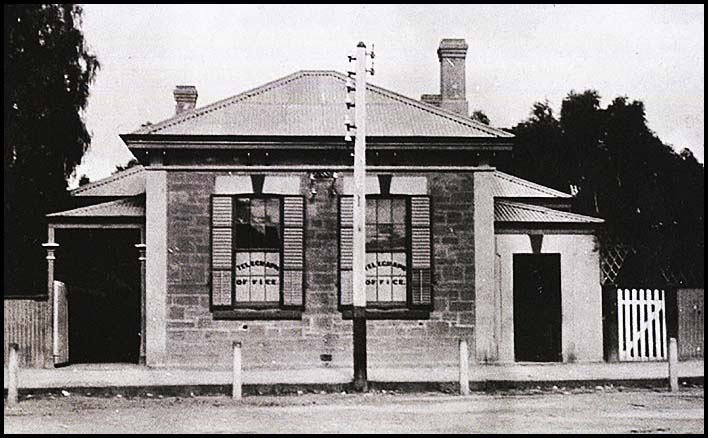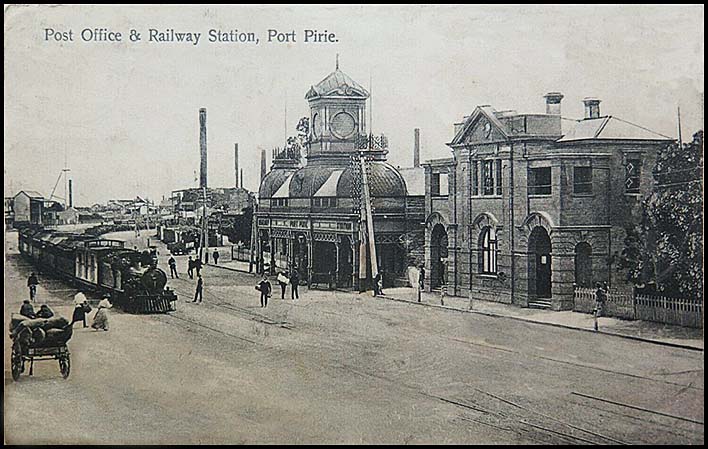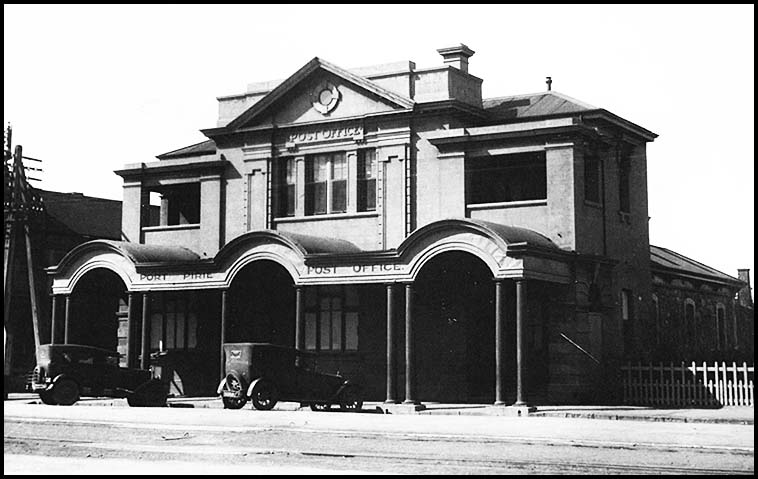Telegraph Offices in the Wallaroo - Morgan - Terowie to Port Pirie region.
- Home, index, site details
- Australia 1901-1988
- New South Wales
- Overview of NSW
- Telegraph lines
- Telegraph Offices
- Date stamps
- Forms
- Envelopes
- Rates
- Stamps
- Queensland
- Overview of Qld
- Telegraph lines
- Telegraph offices
- Date stamps
- Forms
- Envelopes
- Rates
- Stamps
- South Australia
- Overview of SA
- Telegraph lines
- Telegraph Offices
- Date stamps
- Forms
- Envelopes
- Rates
- Stamps
- Tasmania
- Overview of Tasmania
- General developments
- Reports
- Organisation
- Telegraph lines
- Telegraph Offices
- Date stamps
- Railway lines
- Forms
- Envelopes
- Rates
- Stamps
- Overview of Tasmania
- Victoria
- Overview of Vic.
- Telegraph lines
- Telegraph offices
- Date stamps
- Forms
- Envelopes
- Rates
- Stamps
- Ephemera
- Western Australia
- Overview of WA
- Telegraph lines
- Telegraph Offices
- Date stamps
- Forms
- Envelopes
- Rates
- Stamps
The following Telegraph Offices are included in this page:
|
The Adelaide Observer of 21 August 1861 noted that the Treasurer and the Commissioner of Public Works "had visited Auburn on 21 August and had approved of the Government acre (on which stands the Local Court House and Police Station) as a suitable site for the Telegraph Station, tenders for which will, I understand, be advertised very shortly". "Auburn occupies a pretty situation, as the hill slopes to its base, adjacent to the western banks of the Upper Wakefield River, at the point where the two branches of the Adelaide main road, by way of Baker's Springs and Riverton, meet ... At present the Post-Office is conducted at Mr. W. T. Bleechmore's store, but this is shortly to be superseded by the new Post Office, which, conjointly with the Telegraph Station, is to be erected by the Government. The telegraph wires are about to be laid down hence to Wallaroo". (South Australian Register 10 December 1861). In November 1861, Mr. W. Threadgold won the tender for the construction of the Post Office and Telegraph Station at Auburn with an amount of £634/10/-. The Telegraph Office opened on 3 January 1862. The Advertiser announced this event as: Two months later the description was given as "The Telegraph Station now assumes a handsome appearance and is a great ornament to the town". But in April :
As with so many good things, criticism began: "The new Telegraph Station is a very handsome building outside and a great ornament to the village. But the architect, content with a handsome exterior, seems to have expended an immense amount of ingenuity in rendering the interior as inconvenient as possible. His great idea appears to have been the largest possible number of rooms with the smallest possible amount of space and comfort in each. The public waiting-room is just inside the first entrance — is well ventilated by thorough draughts from four doors, and has no fire place. There are small closets both up and down stairs, inserted in the queerest places and just large enough for a moderate sized cat to turn herself round in. larger sized than Swiveller's Marchioness, minus the extensive bonnet. The sitting-room, bedrooms, etc.,are all on the same scale, in short the whole space inside is cribbed and confined to the last degree". (South Australian Advertiser, 5 June 1863, p.2). |
|
Located about 25 km NW of Clare. The Telegraph Office was opened in April 1898. |
|
The telegraph line was opened on 26 September 1879. |
||
|
The Telegraph Office was opened on 20 January 1860. In the second half of 1859, £745 had been allocated for a Telegraph Station and Post Office - the amount to be used before 14 June 1860. On 29 September 1860, the Adelaide Observer announced that "The Post Office will be shifted on Saturday to the Telegraph Station, to be placed under the charge of Mr. Fletcher, who will thus have a twofold responsibility — that of the Telegraph and the Post Office". |
||
|
||
On June 7 1880, the Chess Club in Clare received a challenge from the Chess Club in Narridy to play a competition by telegraph. The Clare Club accepted the challenge pending an agreement from Mr. Todd for them to use the wires. Two of the best players from each club would be involved. The Secretary of the Clare club was instructed to write to Mr. Todd and seek permission. The game was held on the night of 5 July and Clare members won after a game lasting about four hours. |
||
No special date stamp was issued to the Clare Telegraph Office. Squared circle date stamp. Size: 24 × 24 mm. Number in the Census used on telegram: 0. |
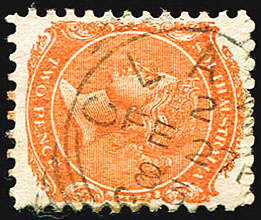 27 February 1883. Used on 2d orange De La Rue. Phoenix Auctions. |
|
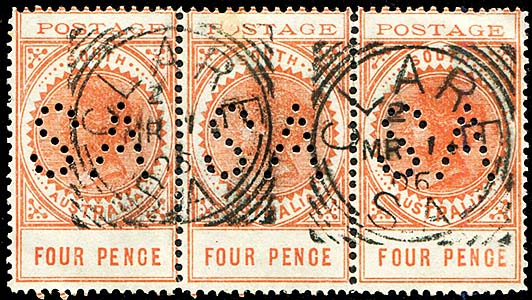 Squared circle date stamp used on strip of 3 4d with SA perfin. 1 March 1906. Could have been used to pay the rate for an interstate telegram of up to 16 words. |
||
SC1: Steel circular date stamp. Diameter: 27 mm. Number in the Census used on telegram: 0. |
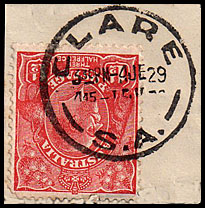 Clare 4 June 1929. Used on 1½d KGV. |
|
|
The Telegraph Office was opened in 1871. It changed name to Farrell Flat in 1940. On Monday 19 January 1874, according to the report in the Northern Argus, "Mr. Martin, the telegraph master at Farrell's Flat, was in his office, when was struck down by lightning and for a time was in a semi-conscious state. After a time he was able to move about and attend to the duties of his office. Still he is suffering a great deal from the shock (understandably)". |
|
| Gladstone.
The South Australian Register of 3 October 1874 reported:
During the afternoon of 28 May 1875, several messages were sent relating to the completion of telegraphic communication with Gladstone. Three years previously, the site of the now Telegraph Office had been a sheep run. Mr Phillips was the first Telegraph Master. The Telegraph Office was opened on 7 June 1875. |
See elsewhere for a 1877 comment on the lack of proper accommodation at both Gladstone and Redhill. The SA Advertiser reported that, on 17 August 1886, "Mr. Todd, the Postmaster-General, with Mr. Knuckey, arrived here yesterday. This morning Mr. Todd visited the telegraph office and the corporation garden, in which place the rain gauge is kept. Both gentlemen proceeded to Port Pirie from here". |
|
Halbury was on the Port Wakefield - Hoyleton tramway between Balaklava and Hoyleton. A Post Office was opened on 1 October 1890 and a Telegraph Office was opened in January 1907. |
|
The telegraph connection was made on 13 September 1878. It was described as a "Red-Letter Day for Hallett telecommunication being opened between here and Adelaide". Accommodation was in a temporary location - perhaps the local store. A letter to the Commissioner of Public Works needed to be sent on 12 January 1880 to call attention to inadequate accommodation afforded by the absence of a Police Station and cells and by temporary Post & Telegraph Offices. On 15 May 1880, the residents of Hallett noted with happiness that the tender for the new Post and Telegraph Office had been accepted. They hoped the tender for the Police Station would also be accepted soon. On 13 September 1880, Hallett experienced very rough weather. This occasioned another request that the Government "should accept tenders for the Post & Telegraph Station". Perhaps the tender had not been signed off. |
|
On 14 September 1874 The South Australian Register (p. 7) noted:
|
|
The Telegraph Office opened on 3 August 1877. CHECK BOTH DATES also 5 May 1877. On 23 December 1884, the Council of Jamestown passed a by-law against the Salvation Army marching and band-playing on Sundays. Trouble was anticipated after the decision received vice-regal confirmation. |
|
Squared circle date stamp.
|
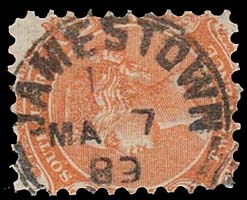 7 March 1889. |
Unlikely to be a telegram usage. |
|
Kadina. The entry for the Kadina Telegraph Office is part of the Cape Yorke Peninsula listing. |
|
The Kapunda Telegraph Station was opened on 11 May 1859. It had been planned to open on Friday 6 May. "Kapunda 12 May: The telegraph was successfully opened to the public yesterday, Mr. Todd having arrived the previous evening and found the circuit complete. The Hon. Captain Bagot and the member for Light, Mr. J. T. Bagot, arrived at noon, to assist in the opening ceremonies. The Station is opened temporarily at the Sir John Franklin Hotel and the spirited landlord had constructed festoons of gay streamers which flaunted across the road to the telegraph-post on the opposite side. (South Australian Advertiser (18 May 1859, p. 5)). |
 Main street of Kapunda about 1925. |
|
|
In the House of Assembly on 15 June 1859, the Commissioner of Public Works said the total receipts (at the Kapunda Telegraph Station) to date had been £17 1s. 6d. That was at the rate of £295 annually which would give a profit of £75 l9s. annually.
On 1 October 1959, the Adelaide Observer reported that the Post Office and Telegraph Station were about to be removed into a new cottage between the Bank and the old Post Office until the new building is completed. Apparently in about September-October the Post Office was moved to be in the same location as the Telegraph Office.
The South Australian Register of 3 January 1860 reported that a further £256/1/6 had been allocated to the Kapunda P&T Office for use before 15 February 1860. |
|
After only about three months of operation, the Telegraph Office played a supporting role when the Admella was wrecked nearby with heavy loss of life. The South Australian Advertiser of 24 August 1859 reported that:
The South Australian Advertiser of 5 November 1859 reported on another incident involving the Telegraph Office:
|
|
|
|
From 1 October 1859, Mr. Darwin had responsibility for both the Telegraph Office and the Post Office. By 1863, Mr Darwin was fully aware of the often incorrect complaints made by a minority of customers. In 1865, he was embroiled in an important legal discussion, also involving Charles Todd, about the legal status of telegrams and who was the actual custodian of them. Some time after, the South Australian Register reported, on 30 August 1865, that "Mr. V. H. Darwin, Postmaster and Telegraph Officer at Kapunda, met with a very serious accident on the 29th, by a fall from his horse. He was found near the main street in an unconscious state and bleeding profusely from the ears. The fall has occasioned concussion of the brain and it is feared more serious injury to the head". Mr Darwin clearly recuperated fully because, in the Kapunda Herald of 20 April 1866, there was a long editorial seeking mention of his good work and calling for "a really good capricious Post-Office, as well as a good telegraphic station, with an ample staff in each, but being quite independent one another (because) the postal and telegraphic services to and from Kapunda are both amongst the most remunerative of their kind and, with the prospects of a still further extension of trade, which has caused two additional Banks to be started there, it is morally certain that the business of these offices will continue steadily ...". On 29 June 1866, Mr Darwin was elected to Secretary of the Kapunda Institute. Amounts of £1,000 were placed on the estimates in 1866 and 1867 for the erection of a new Post and Telegraph Office. In July 1870, many people from the surrounding district attended the monthly sale. It was reported that "everyone was delighted to see the Post & Telegraph Office well-lit with gas for the first time". Presumably this building is the one shown above. |
|
|
The Adelaide Observer of 4 November 1882 noted that "a gentleman from the Post and Telegraph Department would visit Koolunga soon for the purpose of fixing a site for a new Post and Telegraph Office - but as yet no one has been here". The Telegraph Office (finally) opened on 15 February 1884 with Miss Wissen as the Postmistress. Work on the new Post & Telegraph Office had commenced on 19 June 1883 with the total cost being £738. The building was completed during December 1883 but nothing had been done about constructing the telegraph line over the 13 miles from Red Hill - despite a visit in July 1883 by Mr. Knuckey of the Telegraph Department to inspect the road. The line was finally completed by the end of January but the office remained closed despite Miss Wissen taking charge of the building on 29 January. The town was named by Edward John Eyre from the aboriginal name meaning "red banks". |
|
Formerly Burra Burra, the change of name to Kooringa was made during the three months before 29 March 1849. In the second half of 1859, £653 was placed on the Estimates for a new Post Office and Telegraph Station - and work was to be commenced immediately. The Kooringa Telegraph Office was opened on 25 January 1860. It was located in rooms of the Mechanics' Institute and next to the Burra Burra mines.
In the Assembly on 19 July 1861, the Treasurer responded to a question about a petition to amalgamate Telegraph Offices and Post Offices. He said:
On the basis of that amalgamation, th House noted that the amount for renovations at Gawler would now be transferred to Kooringa. A new P&T Office was completed in March 1911. The area had many difficulties because of the way divisions had been made especially in relation to the very large copper mines operated by various groups in the area. On 1 December 1939, the separate townships of Kooronga, Llwchwr, Aberdeen, New Aberdeen and Graham were amalgamated. The name was then changed from Kooringa to Burra. |
|
Squared circle date stamp:
|
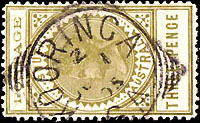 Kooringa squared circle date stamp. 1 December 1905. |
| Laura.
The people in and outside of Laura had been petitioning the Government for some time to provide a Telegraph Station. In both 1873 and 1874, well-attended meetings asked for action to be taken on their requests. Even as of 30 October 1874, the Laura population had "not yet heard anything of the telegraph communication (that we are to have sometime between now and doomsday) beyond a visit from Mr. Cunningham, and it is hoped his visit will help it on, as harvest is fast approaching" (Bunyip (p. 3). The Chairman of a public meeting commented that "no steps had been taken by the Government in the matter, unless a visit from Mr. Cunningham of the Telegraph Department could be called a step". All at the meeting agreed that construction should be completed by the next harvest. Farmers as well as trades people and the general public would be the beneficiaries. The Adelaide Observer of 5 December 1974 reported on a deputation to the Attorney General and the Commissioner of Public Works. In part:
Similar comments were echoed in various press releases on 18 and 19 December. GOOD NEWS TIME: A Telegraph Office was open at Laura on Tuesday 22 December 1874 about two years after the Post Office had opened on 9 September 1872. Clearly this space must have been rented for the sake of opening a service. [ED: Amazing sequence of events. All about the left hand knowing what the right hand is (or is not) doing :) ] Laura was often referred to in the press as being "the prettiest town in the area". |
|
| In the 1877 Estimates, £1,000 was allocated to the Laura Post Office and Telegraph Station. |
|
The Telegraph Office was opened on 18 January 1870. It was a station on the Roseworthy-Peterborough line although it is not known if the Telegraph Office was opened at the station or at another location in the town. The rail link arrived at Manoora on 21 February 1870. The Northern Argus of 11 August 1874 noted:
|
|
The Telegraph Office was opened in 1866. The Estimates had allocated £500 for the half year to December 1865 to complete the Telegraph Station. |
|
The Post & Telegraph Office at the Railway Station was opened in 1874 and renamed Merildin on 1 July 1917. |
|
SC1: circular steel date stamp.
|

Mintaro Rwy Te[leg. Office]. Indistinct date. |
Morgan. Included in the Gawler to NSW region - see elsewhere. |
|
Check - only telephone lines. |
|
The Telegraph Office opened on 28 December 1877. On June 7 1880, the Chess Club in Clare received a challenge from the Chess Club in Narridy to play a competition by telegraph. The Clare Club accepted the challenge pending an agreement from Mr. Todd for them to use the wires. Two of the best players from each club would be involved. The Secretary of the Clare club was instructed to write to Mr. Todd and seek permission. The game was held on on the night of 5 July and Clare members won after a game lasting about four hours. In August 1884, the tender submitted by Messrs. Sara & Dunstan was accepted for erecting a post and telegraph office at Narridy. The tender amount was £760. |
|
|
"Although our telegraph line was completed on Saturday last the Post Office authorities do not seem to trouble about sending an operator as early as they might have done" (South Australian Register 25 February 1888, p. 5).
The Post & Telegraph Office was (finally) officially opened on 5 March 1888 in rented premises. It was opened by "Mr. Sands, when congratulatory messages were forwarded to the Minister of Education and to the Postmaster-General. This will satisfy a long-felt want and prove a boon to the district. A public banquet will be held this evening". A deputation met the Minister of Education on 6 February 1889 seeking for the erection of the Post & Telegraph Office and the Police Station. In a surprise move, the Minister said:
The Area's Express of 26 July 1889 expressed satisfaction with the telegraph line to Port Broughton:
On 2 August 1889, the Area's Express (p. 3), in its review of Port Broughton, commented
|
|
| Port Broughton used a squared circle date stamp up to at least 1912.
In addition to postal use, it was used on telegram forms and - post-1901 - on stamps used to pay telegram costs. |
 |
The block on the right of six 1d red on Crown over A watermark has one complete and three partial strikes. It could have been used to pay the 6d. rate for a telegram sent within 15 miles.
|
|
Ordinary date stamps used on telegrams A squared circle date stamp. |
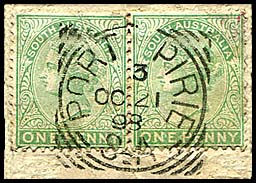 21 October 1898 (on piece). |
RC2 - SA.
|
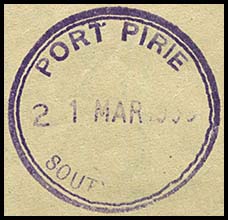 21 March 1955. Used on AW-GSF-54C. |
Port Wakefield. The entry for the Port Wakefield Telegraph Office is part of the Port Wakefield - Salisbury-Barossa listing of Telegraph Offices. |
|
At a public meeting in Riverton on 22 April 1863, Mr. Gurner proposed:
In June a deputation presented the petition containing 248 signatures - mainly from freeholders and leaseholders - to Mr. Bagot. He indicated "he looked favourably as the request". A Proprietor had offered to make a gift of 2 or 3 allotments in the heart of the township for the sire of a Telegraph Station, a Post Office and the Local Court. (Adelaide Observer 20 June 1863). New Telegraph and Post Offices opened on 1 March 1864. Riverton later became a station on the Roseworthy - Peterborough railway line which reached the town on 20 December 1869. A squared circle date stamp could also have been used on a telegram form. The Office was certainly issued with such a date stamp. |
|
|
 4 August 1947. Used on AW-DO-10F (45). |
|
Saddleworth was on the Roseworthy - Peterborough railway line which reached the town in 1870. Hence a Telegraph Office was opened at the Railway Station on 18 January 1870. The Telegraph Office in town opened on 7 June 1877.
|
|
|
On 4 June, 1880 "the Post and Telegraph Office was completed at last, and we hope to be in communication with Adelaide at an early date, as Mr. Sands, Postmaster at Kadina paid us a visit last night for the purpose of making arrangements for opening the office as soon as possible. He also brought a telephone with him and, to the courtesy of that gentleman, we were indebted for an evening's entertainment — several songs, etc being exchanged by well-known gentlemen plainly distinguishable". Congratulatory messages were sent from the residents to the Governor, the Hon. T. King, to the Superintendent of Telegraphs and to Sir G. Kingston. All were suitably acknowledged. But that was a premature event. The Telegraph Office did open a month later on 7 July 1880 - but the telegraph line from Kadina to Snowtown had been completed in March 1879. Prior to the opening, the Yorke's Peninsula Advertiser (p. 3) reported:
A further £750 was spent on the P&T Office in 1883. |
|
|
On 18 October 1879, the South Australian Chronicle reported that "The Commissioner of Crown Land, in answer to Mr. Moody, said the township of Shibear had been withdrawn because the railway line which passed through the allotments had to be reserved. The township would be offered for sale in January, 1880 and its name would be altered to Terowie". The Telegraph line was opened on 21 August 1880. A deputation met the Minister for a lengthy discussion about the location of the Office on 4 May 1881. |
|
Wallaroo. The entry for the Wallaroo Telegraph Office is part of the Cape Yorke Peninsula listing. |
In the House business on 6 July 1865, £125 was allocated for Watervale to be connected to Auburn. Telegraphic communication with Watervale was made on 8 February 1866. |
|
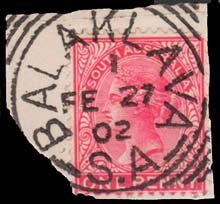
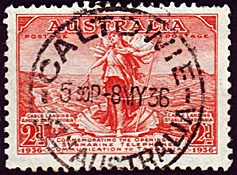
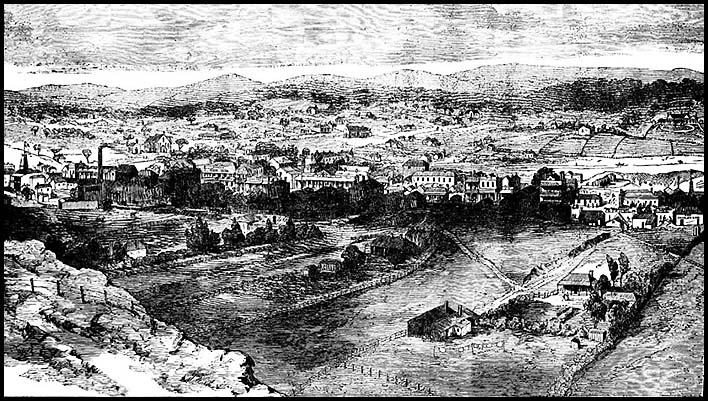
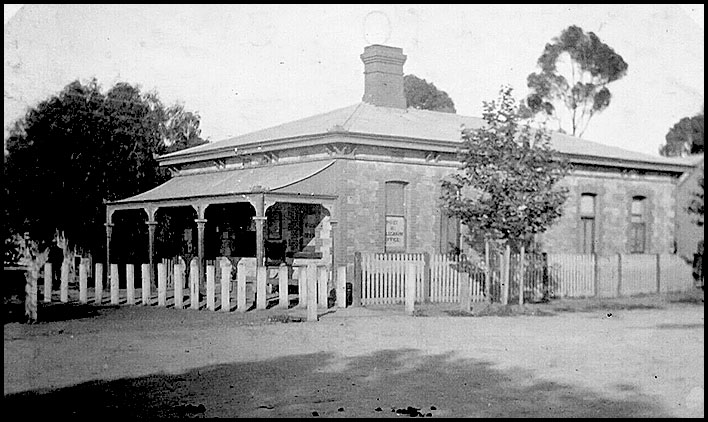

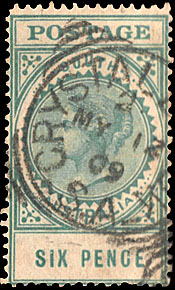
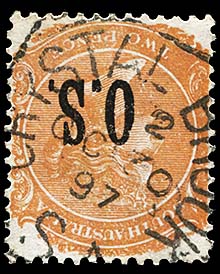
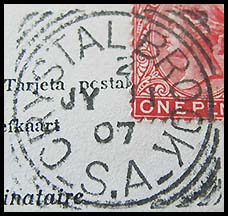

 Used on a ½d green horizontal pair of the GPO om 16 December 1903.
Used on a ½d green horizontal pair of the GPO om 16 December 1903.

